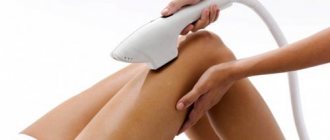Features of laser tattoo removal
Tattoo culture developed gradually.
Today there are 3 general types of skin tattooing on the human body, depending on the purpose:
- Professional drawings. Drawings that are applied under the skin using needles and special equipment. The peculiarity of the work is that pigment paint is fixed at the end of the needle, which is embedded in the upper layer of the skin and remains there for a long time.
- Cosmetic tattoos. This category includes permanent makeup, when the pigment wears off after a few months and requires renewal.
- Medical drawings on the skin of the human body. These are “tattoos” that are applied with safe pigments that indicate the blood type, special information for the upcoming operation, and are erased after some time.
The need to remove a tattoo is most often faced by those who applied the design in a professional way.
The reasons for deletion are most often the following:
- partial abrasion;
- reluctance to see a drawing that reminds of some unpleasant events;
- the need to completely remove the tattoo (for example, this may be due to professional detailing).
Several types of professional equipment are used for laser tattoo removal:
- Ruby laser. This is a device with a rod created on the basis of artificial ruby. The ruby laser works well on black, blue and green pigments. The beam's red range is 694 units. The ruby laser is used to remove tattoos from fair-skinned people. This is due to the fact that melanin actively absorbs the ruby release. When working with a ruby laser, it is necessary to correctly select the beam length. If this is not done, scars will remain on the skin. Ruby laser is strictly prohibited for use if the tattoo has penetrated deeply into the skin. This type of beam is often used for eyebrow tattooing with a penetration depth of up to 1 mm. Ruby is ineffective for blending red, yellow, and orange shades.
- Neodymium laser. The beam removes cold and warm shades. The length of the wave beam for working with neodymium equipment is selected depending on the color of the pigment, while working with a neodymium laser is safer, since there is a limitation on the depth of insertion. The peculiarity of the neodymium laser is the ability of the infrared beam to remove black, dark green, dark blue and yellow-green shades.
- Picosecond laser. The beam destroys the coloring pigment due to photomechanical effects. A picosecond laser is capable of generating a powerful beam and destroying the coloring pigment without damaging the surrounding tissue. The operating technique of a picosecond laser is based on proper selection of beam length and adjustment of equipment with high precision. If everything is done correctly, the effect of a picosecond laser does not leave stretch marks, defects, scars or scars. Working with a picosecond laser is significantly more expensive than removal using other equipment.
- Alexandrite laser. A device with a preset wavelength of 755 units. The beam penetration depth is 1.8 mm. The Alexandrite laser only works to remove dark pigments. The principle of operation is similar to that of a ruby laser. After the first treatment with an alexandrite laser, the tattoo fades significantly, but complete destruction of the design can be achieved only after 5-6 procedures. Alexandrite ray can cause side effects. Blisters, burns, and scars appear on the skin. In addition, the alexandrite laser can cause hypopigmentation.
Neodymium laser device
Laser tattoo removal, reviews of which confirm the effectiveness of the method, is the most modern method. The mechanism of action is based on the splitting of tattoo pigments through exposure to an infrared heat ray.
Experts say that any tattoo can be removed with a laser. Certain problems will arise when removing a pattern made with white pigment. Lasers cannot yet cope 100% with this color due to the peculiarity of the shade. Systematic work on high-quality equipment leads to gradual lightening of the area and the disappearance of traces from the surface of the skin.
There are 2 types of laser beam operation:
- Ablative action. This is a kind of erasing of the pattern, it is often called pilling or laser resurfacing. The mechanism of action is based on removing the top layer of skin simultaneously with the coloring pigment. This method is effective in cases where the pattern is located shallow. Restoration of the upper layer of the epidermis takes 2-3 weeks.
- Selective or selective action. This is a less traumatic removal option, since the laser destroys the coloring pigment without affecting the skin. Selective action means selectivity; in each specific case, specialists select the laser wavelength and its direction.
Similarities and differences in impacts.
| Ablative | Selective |
|
|
Kes Med 810A
This device operates at high frequencies. By installing the laser into the tattoo area, black and blue melanin can be removed. The technical characteristics of the device are designed in such a way that the device does not cause pain and does not provoke allergic reactions. The session takes place in safe mode.
The device is designed for transportation due to its small dimensions. It can be used both in the salon and at the client’s home. The device effectively copes not only with tattoos, but also with other tasks:
- Eliminates unwanted pigmentation in the face and entire body
- Fights vascular dilations. Before the procedure, you must consult a doctor
- Elimination of unwanted vegetation
- Carrying out a carbon peeling session
- Eliminate a permanent
- Freckle removal
The laser device penetrates into the deep layers of the patient's skin. Heat is responsible for breaking down the skin at the cellular level.
This neodymium laser is not cheap, starting from 200,000 rubles, but the quality of the products from this Beijing factory is impeccable.
Cost of laser removal
Laser tattoo removal is a fairly expensive procedure. According to reviews, complete mixing costs several tens of thousands of rubles.
Experts prefer to calculate the cost per square centimeter:
- 1 sq. see – from 1200 rub.;
- plot 10x10 cm – from 3000 rub.
Tattoo removal with a picosecond laser
The minimum fixed price for the work is 1200 rubles. for 1 session. To remove marks, it takes from 3 to 5-6 sessions.
When visiting the specialist for the first time, the client is informed of the approximate cost of the procedure. The price may increase if additional difficulties arise during the work.
What questions to ask the medical staff
A conversation with medical staff allows you to find out as much information as possible before the procedure.
First, find out what services the doctor provides. There are narrower specializations in cosmetology.
A person practicing chemical peeling or mesotherapy should not perform tattoo removal procedures unless he has the appropriate education certificate.
The master must tell and show:
- How will the procedure take place?
- What materials will be used;
- What drugs are used to reduce pain.
You should learn about possible complications, side effects, and guarantees.
Pros and cons of using lasers
In addition to laser removal, there are alternative methods.
A brief overview of the techniques allows you to evaluate the advantages of choosing a laser:
- Surgical removal. This is the most traumatic method, which is used only in emergency cases. To remove pigment, dissection of the skin is practiced.
- Chemical bleaching. An alternative to laser exposure, which involves the use of special bleaching ointments. On the one hand, the technique completely eliminates skin injury. On the other hand, it affects all systems of the body, as chemicals enter the blood and spread through the bloodstream.
- Nitrogen treatment. This is a kind of burning, which leads to necrosis of the top layer and further exfoliation. This method is considered relatively inexpensive, but one of the most painful.
Laser removal is a modern and effective technique that is suitable for those who decide to get rid of a tattoo. Possible side effects are associated with a violation of the technique of applying the original design or the use of low-quality coloring pigments. If the tattoo was done in a salon using good equipment, then laser removal in several sessions will lead to the complete disappearance of images from the surface of the skin.
SL NEO
Country of origin: China. The device is used to remove tattoos of any color and condition. In addition, the SL NEO device has a rejuvenating effect, removes pigmentation, smoothes scars, fights stretch marks and wrinkles. Today this equipment is a sales leader.
Two attachments are provided with the device:
- 1064 nanometers to remove dark tattoos
- 532 nanometers for red and brown pigment removal
- 1320 nanometers for skin rejuvenation and tightening, wrinkle removal
Important!
The advantages of this device are its affordable price and decent quality of the product, which uses components from Europe and Japan
Advantages of the SL NEO laser device: The procedure is non-invasive, so the device does not deform the epidermal area
- The rehabilitation period ranges from 2 to 4 days
- The device eliminates the possibility of infection, wounds and scars.
- The device is designed for transportation, so it can be used both in the salon and at home
Contraindications to the procedure
The procedure has contraindications. There is a list of possible risks that the client is introduced to before signing consent for manipulation.
It is strictly forbidden to work with a laser if the following conditions exist:
- presence of hematomas on the body;
- development of an infectious disease;
- bleeding of any type;
- the presence of scars and cicatrices;
- presence of allergies;
- blood diseases;
- diseases associated with impaired brain activity;
- various skin diseases: eczema, acne.
Possible complications after the procedure:
- manifestation of hyperpigmentation of the skin;
- changes in skin structure, which may be temporary or permanent;
- darkening of the tattoo;
- change in shade, but not complete disappearance of pigment.
LF-657
This device for removing tattoos is very popular among cosmetology elephants, as it has a high level of efficiency. The device is able to eliminate colored tattoos, the paint of which has penetrated deep under the epidermis. The laser can remove decorative tattoos, birthmarks, age spots, and freckles.
The device offers the function of carbon skin rejuvenation, resulting in a visible transformation. To carry out this procedure, a special attachment is used that tightens pores, tightens and whitens the skin, and also reduces the number of wrinkles. The device can operate at a minimum voltage of 220 Volts. Country of origin: China. The factory provides a warranty period of one year. The wavelength of the LF-657 laser reaches a maximum of 1064 nanometers, which allows you to remove tattoos even from the deepest layers of the skin. The power of the device is 800 watts. The length of the wave action is adjustable. The weight of the device reaches 30 kilograms, so it can be transported with some effort. The price of the device is 120,000 rubles.
Preparation for the procedure
Laser tattoo removal, reviews of which indicate its effectiveness, is a procedure that requires proper preparation. The quality and effectiveness of the result depends on compliance with the requirements.
Typical recommendations:
- For several weeks before visiting a specialist, it is recommended not to use sunscreen and avoid being in direct sunlight.
- You cannot depilate the part of the skin on which the tattoo is applied.
- Do not use exfoliating products, which include peelings and scrubs.
- Smoking is not recommended for several weeks before surgery.
- You should not take anti-inflammatory drugs or folk remedies that affect blood flow.
- A few hours before the procedure, you should drink as much water as possible.
It is impossible to completely remove a tattoo from the skin in one session. Complete discoloration can be achieved only after several sessions and restoration measures.
ScinOneUltra II
The device acts as a multifunctional pulsed ND:YAG premium segment. Used to remove tattoos, make-up and carbon-based peeling.
Even the most problematic, deep and old tattoos can be affected by this neodymium laser. The result is ensured due to the increased radiation density. Advantages of the laser device:
- Strength
- Good payback
- Good pulse energy performance
- Fine adjustment of output energy
- Result guarantee
The large volume of the radiator, as well as the speed of cooling, allows it to function without interruption for six hours.
For your information.
Recently, a new version of this laser, ScinOne Ultra X, has appeared, more compact, but also more expensive, starting from 300,000 rubles.
How does laser tattoo removal work?
The general scheme for removing pigments from under the skin using a laser is the process of heating microparticles of coloring pigment to a state where they begin to disintegrate. After the particles break down, the paint is washed out naturally through the lymphatic system.
The rate of removal of microparticles depends on additional factors:
- depth of pigment introduction;
- quality of coloring pigment;
- density indicator of the applied pattern;
- localization areas on the body;
- quality of the device;
- professional qualities of a specialist.
The removal process is carried out in several successive stages:
- First, the patient is given safety glasses.
- Then a skin reaction test to the laser is performed.
- Select the appropriate power.
- Skin is treated with laser.
- Then a cooling agent is applied to the treated area and a protective bandage or patch is applied.
In some cases, tattoo removal requires anesthesia to lower the patient's pain threshold. In this case, local anesthetics are used or injections with painkillers are given.
Recovery period
Laser tattoo removal, which has numerous reviews, requires careful attention to the recovery period. In most cases, you can immediately return to normal life after the procedure.
But during the time when the skin is actively recovering, it is necessary to follow general recommendations:
- You cannot steam your skin for 14 days after the procedure;
- visiting baths, saunas or swimming pools is completely excluded;
- It is strictly forbidden to sunbathe or visit a solarium (such steps lead to injury and scarring).
If we are talking about removing a tattoo or tattoo on the face, then you should not use decorative cosmetics for several days in a row. For the body, avoid using alcohol-based products completely. It is also better to completely eliminate the possibility of exposing the treated area to hot water, rough clothing or synthetic dressings. It is necessary to avoid contact of injured skin with chemicals.
No special care is required for the removal area unless necessary. Experts recommend using a healing agent if the removal did not go as expected. You should not use special means to remove the resulting swelling. If everything is done correctly, the swelling will go away on its own in a few hours or a few days.
Key-360
The device acts as a multifunctional pulsed ND:YAG economy segment. Used to remove tattoos, make-up and carbon-based peeling.
Even the most problematic, deep and old tattoos can be affected by this neodymium laser. The result is ensured due to the increased radiation density.
Advantages of a laser device:
- Strength
- Good payback
- Good pulse energy performance
- Fine adjustment of output energy
- Result guarantee
The large volume of the radiator, as well as the speed of cooling, allows it to function without interruption for six hours.
How painful is tattoo removal?
Laser tattoo removal causes pain and discomfort. 90% of patients compare the sensations after tattoo removal with the sensations that arise during the process of applying it.
The following factors play a special role:
- tattoo location area;
- pain threshold, which is individual for each person.
The most dangerous and sensitive areas are those located near large veins. The sensitive areas of the upper body are the least sensitive. The most painful places to remove designs are from the wrist, palms, face, upper back, and neck. To determine the sensitivity of the area, the rule works: the larger the fat deposits under the skin, the less painful the effect.
What can influence the effect
Laser tattoo removal, reviews of which speak of effectiveness, is actually not always effective. It depends on related factors.
Laser tattoo removal with alexandrite laser
The effectiveness of the chosen method can be influenced by the following properties:
- Applying drawings using an artisanal method. In this case, the quality of the pigment dye turns out to be very low; non-professional equipment is most often used to introduce it under the skin, so the dye is unevenly located under the skin. This means that removal requires adjustment of different wavelengths.
- An overabundance of yellow and orange shades. It’s quite difficult to create a warm color palette. Pigments of yellow, orange and red are “stubborn” paints, as experts call them. For their information, a neodymium laser is recommended. In addition, green tones may turn pink or fade unevenly when exposed to rays. White paint under the influence of a laser beam acquires a greenish tint.
- Tattoo style. For removal, the tattoo technique is of great importance. If a person removes a tattoo with shading, then it takes less time than to remove a design with a clearly defined outline.
How many sessions are required for permanent tattoo removal?
The duration of one session lasts approximately 20-30 minutes. To treat a skin area with a total area of 10x10 cm and completely remove a small tattoo, 3-5 sessions will most often be required. Please note that the recommended recovery and rest periods must be observed between sessions. The rehabilitation course is at least 1-1.5 months.
The wizard sees how many sessions will be required only after the start of work. In some cases, if the pigment quickly deteriorates, the number of sessions can be reduced to 2. Removing large tattoos that cover different areas of the body takes 8-12 months, taking into account rest periods between sessions.
Laser tattoo removal is a modern and effective method. To completely get rid of a tattoo, you should choose the correct method of reduction. According to customer reviews, the main importance is the skill and professional qualities of the specialist who carries out the work, as well as the ability of the patient’s skin to actively recover.
Lasertech H101
In fifth place is the Lasertech H101 neodymium laser device. The manufacturer offers a two-year warranty. Most salons purchase this particular device because it can pay for itself in the shortest possible time. The cost of the device is approximately 150-160,000 rubles.
The device is intended for transportation and weighs 18 kilograms. There are built-in safety sensors that can monitor water flow, temperature and electrical fuse.
Lasertech H101 has increased durability characteristics since the body is made of polyvinyl chloride. The device features a color touch screen in Russian. The cooling system has water and air cooling, with which the equipment can be in an active state for about 12 hours. The device's handpiece has a flash counter.
For what purposes is this laser used:
- Removes tattoos without causing pain. The rehabilitation period is minimal, there are no side effects
- Eliminates permanent hair without affecting other tissues
- Polishes scars
- Eliminates spider veins, restores problematic capillaries
- Eliminates existing stretch marks, increases collagen production
- Performs carbon peeling
Attention!
The laser was produced in one of the factories in Guangzhou, so the quality is not very high. And the price is too high for this class of equipment.











